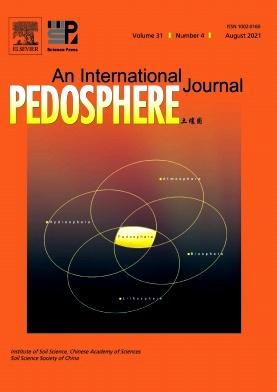不同磷源对水稻厌氧及向日葵和玉米好氧条件下砷毒性的缓解作用
IF 5.2
2区 农林科学
Q1 SOIL SCIENCE
引用次数: 0
摘要
砷污染是造成环境污染的主要因素之一,严重影响作物生产的可持续性。纳米羟基磷灰石(nHAP)可以作为一种有效的磷源来应对砷中毒。评价了不同磷源对碱性土壤中水稻、向日葵和玉米砷毒性的缓解作用。砷以0和20 mg kg-1的剂量施用,磷以0、50和500 mg kg-1的三过磷酸钙(TSP)和nHAP的形式施用。另外,在向日葵和玉米试验中,与其他磷源施用相同量的磷酸。采用傅里叶变换红外光谱、x射线衍射、扫描电镜和能量色散x射线能谱对nHAP的结构和功能特性进行了表征。水稻发育不良,向日葵发育不良;玉米未受砷毒性影响。在As、TSP和nHAP存在的情况下,高剂量(500 mg kg-1)水稻干重显著高于对照(0 mg kg-1)。在50 mg kg-1 TSP和500 mg kg-1 nHAP的作用下,水稻中砷的浓度降低了约25%。施磷处理对向日葵As浓度无显著影响,而500 mg kg-1 TSP可提高玉米As浓度。在没有和存在As的情况下,50 mg kg-1 nHAP处理显著提高了水稻磷浓度,而在存在As的情况下,500 mg kg-1 TSP处理显著提高了水稻磷浓度。砷对向日葵磷浓度无显著影响,而在0 mg kg-1磷处理下玉米磷浓度降低。综上所述,TSP和nHAP对水稻和向日葵的砷毒性有较好的缓解作用。需要进一步进行比较研究,以确定TSP和nHAP在田间条件下预防As毒性的长期效果。本文章由计算机程序翻译,如有差异,请以英文原文为准。
Mitigating effects of various phosphorus sources on arsenic toxicity under anaerobic conditions for rice and aerobic conditions for sunflower and maize plants
Arsenic (As) contamination is one of the major factors that contribute to environmental pollution, and it plays havoc with sustainability of crop production. Nano-hydroxyapatite (nHAP) can be an effective phosphorus (P) source to cope with As toxicity. The mitigating effects of variable P sources on As toxicity in rice, sunflower, and maize grown in an alkaline soil were evaluated. Arsenic was applied at 0 and 20 mg kg-1, and P was applied at 0, 50, and 500 mg kg-1 in the forms of triple superphosphate (TSP) and nHAP. In addition, the same amount of phosphoric acid was also used in the sunflower and maize experiments with the other P sources. The structural and functional properties of nHAP were determined by Fourier transform infrared spectroscopy, X-ray diffraction, scanning electron microscopy, and energy-dispersive X-ray spectroscopy. Stunted growth was observed in rice, and less in sunflower; maize remained unaffected by As toxicity. In the presence of As, TSP and nHAP at their high doses (500 mg kg-1) significantly increased the rice dry weight compared with the control (0 mg kg-1). The As concentration in rice was decreased by approximately 25% in the presence of 50 mg kg-1 TSP and 500 mg kg-1 nHAP. The P treatments had no significant effect on the As concentration in sunflower, whereas the As concentration in maize was increased by 500 mg kg-1 TSP. In the absence and presence of As, nHAP at 50 mg kg-1 significantly increased rice P concentration, whereas in the presence of As, 500 mg kg-1 TSP significantly increased P concentration in rice compared with the control. Arsenic had no significant effect on sunflower P concentration, while the maize P concentration was decreased in the 0 mg kg-1 P treatment. It can be concluded that TSP and nHAP were effective in alleviating As toxicity in rice and sunflower. Comparative studies are further needed to determine the long-term effects of TSP and nHAP on prevention of As toxicity in field conditions.
求助全文
通过发布文献求助,成功后即可免费获取论文全文。
去求助
来源期刊

Pedosphere
环境科学-土壤科学
CiteScore
11.70
自引率
1.80%
发文量
147
审稿时长
5.0 months
期刊介绍:
PEDOSPHERE—a peer-reviewed international journal published bimonthly in English—welcomes submissions from scientists around the world under a broad scope of topics relevant to timely, high quality original research findings, especially up-to-date achievements and advances in the entire field of soil science studies dealing with environmental science, ecology, agriculture, bioscience, geoscience, forestry, etc. It publishes mainly original research articles as well as some reviews, mini reviews, short communications and special issues.
 求助内容:
求助内容: 应助结果提醒方式:
应助结果提醒方式:


